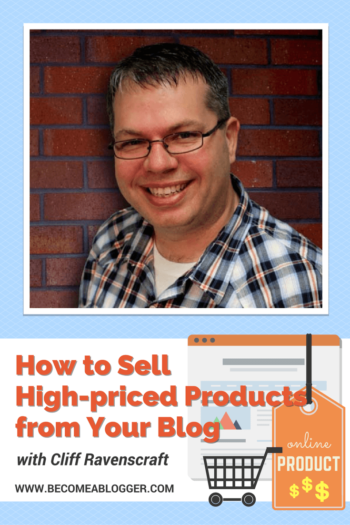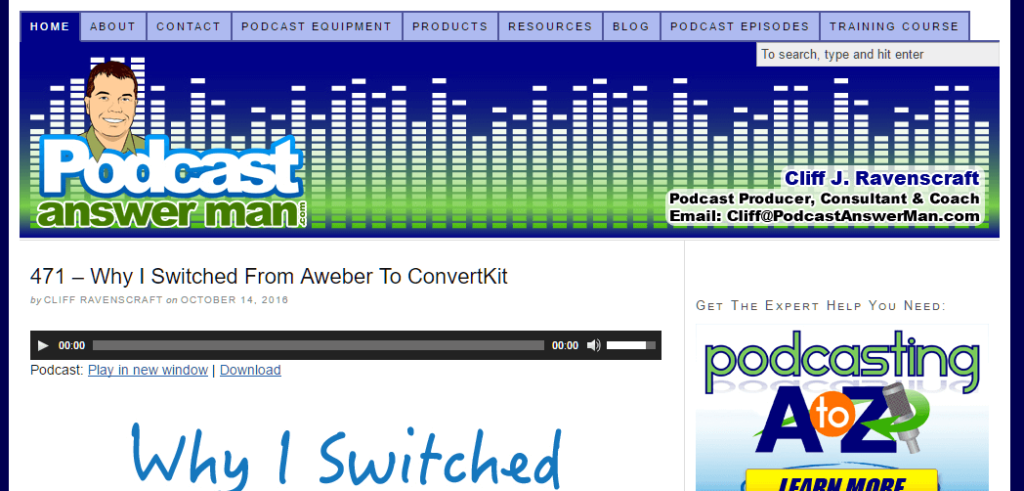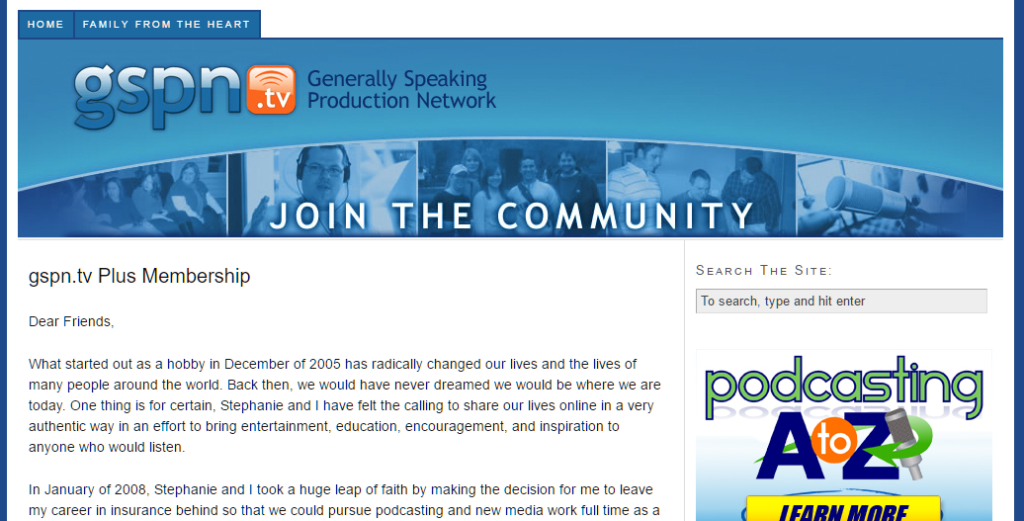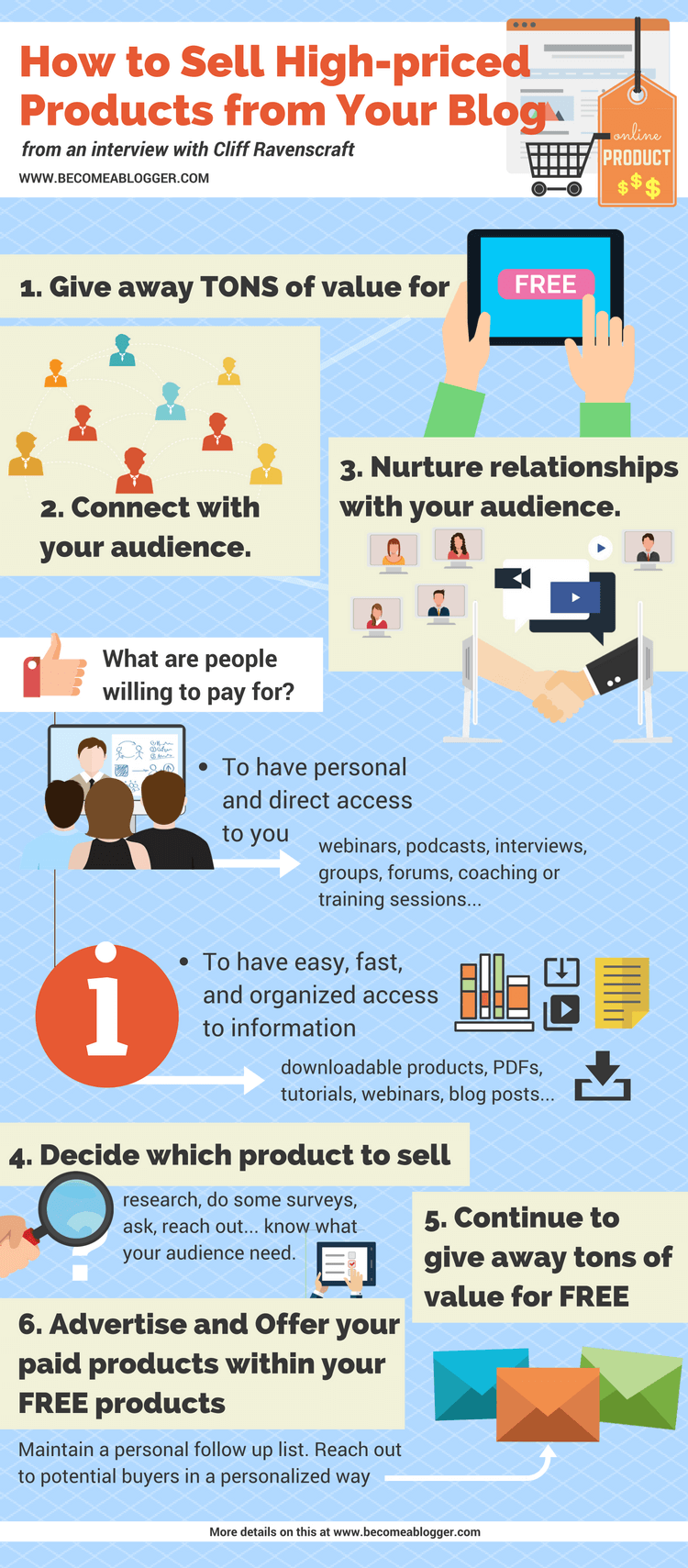Episode: 283
Who: Cliff Ravenscraft
Blog / Website: Podcast Answer Man
Are you charging as much as you could for your digital products?
Are you nervous about increasing your rates?
In today’s episode, I’m on the line with none other than Cliff Ravenscraft, a.k.a the Podcast Answer Man and host of the Cliff Ravenscraft show, a podcast devoted to helping you take your message, your business and your life to the next level. He started podcasting as a hobby way back in December 2005 and has since created more than 30 different shows and an amazing 3,300 podcast episodes. He has personally helped thousands of people launch extremely successful podcasts through one-on-one coaching, consulting, and his Podcasting A to Z online training course.
I brought him on today to talk about how to sell high-priced products from your blog. This is something that scares many bloggers, myself included, but is something that can REALLY help us take our businesses to the next level.
If this all sounds really familiar… well, we tried to cover this topic two episodes ago, and Cliff totally derailed the show with his enthusiasm for changing the world! But I promised we’d come back to the topic of selling high-priced products, so here we are. We promise to stay on topic this time.
Cliff’s Story


Cliff started out with a very successful insurance career in his family business. The company had been running since 1935, and he was next in line to take over when he left insurance to pursue podcasting full time in January 2008. At the time, he had been podcasting for about two years.
Cliff started podcasting as a hobby. He was doing well financially, and he didn’t ever think that he’d be building a business based on his podcasts. His first investment in podcasting was a $35 microphone from BestBuy. A little while later, when his wife Stephanie joined him on his Lost podcast, he bought another mic for about $90. So he hadn’t spent a ton of money, and he knew nothing about sound quality, but people really connected with his show. He had thousands of listeners by the third episode!
One day, a listener sent a message saying that she loved the show, but she wished that the sound quality was better. She asked how much money Cliff and Stephanie would need to purchase higher quality microphones, and offered to write a check. From that point on, donations started coming into the show. Cliff and Stephanie set up the Generally Speaking Network at GSPN.tv to host all of their content. If you go to GSPN.tv/check, you’ll see the biggest donation they ever received–$12,000!
Soon, Time Warner Cable was calling and asking to advertise on the show.
At one point, Cliff and Stephanie were using a site called TalkShoe.com, which allowed them to broadcast their podcasts live and to take live callers. TalkShoe was just a startup at the time, but Cliff’s podcasts brought in so much traffic that they wanted to make a deal with him. They needed content hosted on their servers in order to attract advertisers. So they paid Cliff between $1,000 and $5,000 per month to host his show with them, while they were making $0 in ad revenue themselves.
Within a year of launching his first podcast, Cliff and Stephanie were running six different shows.
Building a Business
One of Cliff’s shows was the Podcast Answer Man. He has so many people emailing him to ask questions about podcasting that he thought it would be better to just create a podcast devoted to answering them. And then, he had another idea: would anyone actually pay him to teach them how to podcast? Would they pay $150 for a 90-minute webinar?


Yes, they definitely would. He sold out immediately, and people loved the content. They encouraged him to do more, and to charge a lot more money for it.
At that point, Cliff started doing one-on-one coaching at $50 per hour. He was starting to think about leaving his job in insurance to pursue podcasting full time. But his rates were too low. He says that at this point, he was closing with 3 out of every 10 people that approached him about coaching. So he had a 30% success rate with convincing people to actually sign up. He thinks that the number was so low because people didn’t take him seriously at $50 per hour. They might have been thinking that he wasn’t any good if his rates were that low.
Life was “pretty insane” for Cliff at that point. He says that his priorities were way out of whack. In addition to all of the podcasting he was doing, he was putting in 50 to 60 hours per week in his insurance job as well as volunteering with his church. He was making a ton of money, but he was burning out.
Full-Time Podcasting
Cliff says it’s really important for you to know what his financial situation was when he left his job in insurance. By the time he decided to leave his insurance job, he and Stephanie were virtually debt-free. Their only remaining debt was their mortgage payment.
He’s in a single-income family: Stephanie is a stay-at-home mom with their three kids. So it was important to Cliff that he would still be able to provide for the family when he started podcasting full time. Being debt-free was a big part of that.
He also had several income streams set up through his podcasts. For example, he had a sponsored podcast at the time that, over the course of four years, paid off their mortgage all by itself!
In addition, he had affiliate income of about $1,500 to $2,000 per month. He was also earning between $2,000 and $3,000 per month for consulting and one-on-one coaching. And, finally, he was making $3,000 to $5,000 per month in equipment sales, as an official reseller for some of the equipment he used.
Within a couple months of leaving his job, Cliff was working with Stephanie to create between 7 and 15 podcast episodes per week. This was to keep their existing podcasts going while also creating content for their GSPN Premium Membership program. For $10 per month, Premium Members got access to all of their content on the site. This is not something that he would ever do again, or something that he recommends, but at its peak the program generated about $28,000 per year.


Still, the majority of his income was coming from equipment sales at first. $50 per hour for consulting was just not sustainable, so he raised his rate to $95 per hour. He struggled with that decision, wondering who in the world would pay $95 per hour. He thought, “people are going to spend $95 for an hour to talk to me about something I love? This is crazy!” But as soon as he increased his rate, his success in closing deals improved, too. He went from 30% to 50% success almost overnight.
Cliff says he used to think that the harder your job was or the harder you worked, the more money you should be paid. But that’s all wrong: now, he says, he knows that it’s all about how much value you add to the life of the person paying you.
One-Year Anniversary
Still, at the end of his first year he was “squeaking by.” He brought his consulting rate up to $150 per hour, and he saw his success in closing clients go up to about 80%. He found that once he increased his prices again, his clients were much more relaxed and willing to let him add value to the calls instead of just answering the questions that they came in with. A number of clients told him that he should double his rates.
Cliff’s business was profitable after the first year, but he only earned $11,000.
At the time, he was still spending most of his time and earning most of his income from equipment sales, which involved a lot of free consulting on his part in the hope that the customer would purchase the equipment. Around the same time, he met Dan Miller, author of the best-selling book 48 Days to the Work You Love. Dan and Cliff got along really well, and Dan started sending over members of his audience who wanted to learn about podcasting.
That was great, but Cliff’s consulting schedule started filling up weeks and weeks in advance. He was spending so much time on the equipment sales that he was really limited in terms of the amount of time he could spend on consulting and coaching. After talking about this problem on one of his podcasts, Pursuing a Balanced Life, one of his listeners chimed in with three words that changed his life: Stop. Selling. Equipment.
The listener had done the math: with all the hours that Cliff was spending on equipment sales, he was only earning $22.50 per hour. Why would he continue doing that when people wanted to pay him $150 per hour for coaching?!
So Cliff quit equipment sales and started doing 25 hours of coaching per week. And, of course, his income shot right up.
In a Mastermind meeting not long after that, Cliff’s group tried to convince him to increase his rates to $300 per hour. But he just wasn’t confident enough. He felt safe at $200 per hour, but not $300. Eventually, they decided that if he wasn’t confident enough to go there, he shouldn’t do it. If he wasn’t convinced that he was worth $300 per hour, how could he convince anyone else?
Nowadays, Cliff charges $1,500 per hour for coaching.
Digital Products
Cliff started to notice that he was getting a lot of repeated questions in his coaching calls. One day, he had four clients in a row all asking about how to use Adobe Audition because he had recommended it on his podcast the week before.


So in October 2010, he reached out to his mailing list and pitched a series of seven, two-hour webinars answering his most frequently asked questions. Whereas a two-hour coaching call would have cost $600 at the time, he was offering these webinars for $100 each or $595 for all seven.
Once he launched the program, he made $16,000 in 10 days. Crazy! That money allowed him the time to plan and build the tutorial videos. Now, when a coaching client asks one of those seven questions, he gives them access to the tutorial free of charge, so that they can move on to more exciting questions.
His current product, Podcasting A to Z, is significantly higher in price.
Strategies for Selling
One of Cliff’s top strategies for selling high-priced products is to give away tons of value for free. He does this through his podcast.
Cliff has found that people are willing to pay for 2 things:
- Personal, direct access to Cliff
- Easy, fast, and organized access to information


Most of the content of Podcasting A to Z can be found within Cliff’s podcasts. But the course organizes the information in a way that’s easy to access and understand. Instead of having to search through hundreds of episodes, they can quickly and easily find the information they’re looking for. And if they have a question, Cliff is always available to help.
Cliff says that his podcast is the number one thing he uses to advertise his course. He promotes the course at the end of every episode. Why? The people still listening at the end are the only people who will be willing to spend $2,000 on the course.
He also brings in successful Podcasting A to Z alumni for interviews on the podcast. This is strategic: they may or may not mention the impact that the course had on them, but Cliff will always mention that they took the course. It’s powerful social proof.


Snapchat is another tool that Cliff uses. It’s proven very effective for him. He once made $6,000 in a day! But the same principles still apply: you’ve got to give away lots of value for free before you start advertising your paid product. So Cliff posted from January to May of this year, every day, with no marketing message at all.
It was a great way for him to reach a new audience. Cliff devotes an hour every day to interacting with Snapchat followers, answering questions, and building relationships. When you do make your sales pitch, those relationships will really pay off. When Cliff finally advertised the Podcasting A to Z course on his Snapchat, three people signed up right away. All of them were people that he interacted with regularly.
So basically, to sell your high-priced product, you’ve got to provide a ton of value up front, build relationships over time, and then make the ask.
Any Other Tips?
Cliff says that his sales and marketing training from his insurance days has been extremely useful. If you have or you can acquire those skills, they’ll definitely serve you well.
He also maintains a personal follow up list. This is so that he can reach out to potential buyers in a personalized way. Here’s how it works:


Any time someone emails him with a question and expresses any interest at all in Podcasting A to Z, he saves their contact details and the content of their message in Evernote. Then he sets a follow up date.
When it’s time to follow up, Cliff personalizes the content of the email based on what was in the first message. He also includes anything else he knows about this person. He’ll “stalk” them on social media and see what they’ve been up to, so that he can show that he really cares about providing value for them.
If that person still isn’t ready to commit to the course, he’ll follow up again. This shows that he really believes in his product and believes it’s a worthy investment.
Sometimes, when he’s had a few follow up emails with someone, but the interaction isn’t as warm as it was at the start, or it’s feeling a little stale, Cliff will include a personalized video in his next message. He’ll take everything he knows about the person and sit down to make a quick video, just talking to camera. This is a powerful marketing tool because there’s no way it could be a form letter. It’s definitely personal, and it makes that person feel very valued.
Where Can I Find Out More?
If you want to hear more from Cliff, you can find his podcast on podcastanswerman.com.
If you’re interested in the Podcasting A to Z course, head on over to podcastingAtoZ.com.
Resources Mentioned
- Podcast Answer Man – Cliff's blog/website
- Cliff Ravenscraft show – Cliff's podcast devoted to helping you take your message, your business and your life to the next level
- Podcasting A to Z – his online training course
- This Interview Was Derailed by Cliff Ravenscraft’s Enthusiasm – My previous interview with Cliff
- Generally Speaking Network at GSPN.tv – where Cliff and his wife, Stephanie host all of their content
- GSPN Premium Membership program – where premium members can get access to all of their content on the site
- TalkShoe.com – allows podcasters to broadcast their shows live and talk to live callers
- Snapchat – another tool that Cliff uses to build his audience by interacting with Snapchat followers, answering questions, and building relationships.
- Evernote – where he saves contact details of people he wants to follow up with in the future.
Infographic


